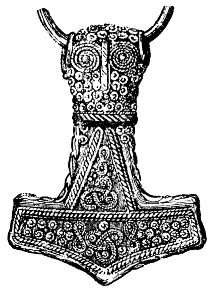An interesting question indeed Pangaea and I admit I will have to look up some stuff myself.

The first thing that does come to my mind is the famous hammer "Mjˆnir" which in viking sagas is the weapon of the God of thunder, Thor. Those sagas preceded the more frequent use of hammers in medieval warfare. I know that the hammer Mjˆlnir has been a symbol used in viking ornaments and trappings. I am not aware of actual war hammers being found in excavations of viking villages, graves or the like (but having not searched for it specifically I am not sure if such hammers may have been found anyway). A weapon often associated and definitely found by the vikings have been battle axes.
As for war hammers I think I once read many European knights were kind of reluctant to pick it up for a weapons as it was deemed as kind of "profane" for resembling a tool rather than a weapon. However, with the improvement of armor in the later middle ages which rendered the wearer ever less vulnerable to swords blunt weapons or weapons which focused a lot of force on a very small point to penetrate armor became more accepted and frequently used (especially in 15th century). War hammers often combined both, blunt forth and a sharp point by the hammers head having a flat side on the one and a sharper thorn on the other end.
Another thing that is remarkable is that, if we can trust the Bayeux Tapestry, the leaders of the Normans (after all descendants of the vikings) wielded wooden clubs rather than swords during the battle of Hastings as early as 1066.
Clubs and maces probably rank among the earliest weapons in human history and due to the simplicity and availability of clubs or simple maces they can be found in pretty much all cultures. In human history. It is sometimes difficult to specify where the mace ends and where the hammer begins. I am not aware of a people though where hammers were the dominating weapon (like the sword was in many cultures).
From here on I need to check out other materials to learn about whether or not war hammers have been found at any viking excavation sites.
Having done a little more research it seems that old norse texts mentioning or ornaments depicting Mjˆnlir date as far back as 9th century. Apparently the descriptions are not always quite clear on whether it was really a hammer, a mace, or an axe. This is what a medieval trapping of Mjˆlnir (of which there have been many modern copies or "reinterpretations") looks like:

However, I haven't found any reference anywhere of war hammers being found at viking sites or war hammers other than Mjˆnir being depicted in viking art.

